WHITE PAPER: AI Investment Landscape Primer
Understanding the Ecosystem, the Opportunity and the Path to Value
Artificial intelligence (AI) has arrived and invigorated investment markets. Like electricity and the internet before it, AI is not a single innovation but an enabling force driving a new economic era.
For investors, AI represents both a generational opportunity and a complex challenge. Its rapid evolution is redefining business models and capital flows. Yet for all the excitement, it remains difficult to determine where value will ultimately accrue and how to build risk-adjusted exposure to this technology.
Key Takeaways
- AI represents a once-in-a-generation investment opportunity: The pace of adoption across consumers and enterprises is faster than any previous technology shift.
- Value in AI accrues across interconnected layers: The AI ecosystem spans hardware, AI infrastructure and data centers, energy, foundational models, cloud and delivery platforms, data and AI applications and software. Understanding these layers is essential to identifying where value is created and sustained.
- The AI application and software layer is emerging as a key pillar in the AI economy: With proprietary data, direct customer relationships and measurable productivity impact, software companies are positioned to convert AI innovation into enduring enterprise value.
- Public markets offer scale and accessibility, but private markets offer alpha: Public equities – particularly large-cap technology and infrastructure leaders – represent the most direct and diversified way to access AI exposure. However, these markets are already crowded with capital. In contrast, private markets offer greater opportunity for differentiated returns and active value creation.
- Private equity and private credit offer distinct pathways to participate: Private equity offers investors a pathway to invest in smaller, high-growth companies and the potential to generate alpha relative to public-market peers. Private credit provides income-oriented participation with lower volatility and attractive downside protection.
- Portfolio construction depends on risk appetite and access: While public markets provide exposure to established leaders, we believe there are compelling opportunities in the private markets.
What Is the AI Ecosystem
Thinking in Layers and Waves
Understanding AI as an investment opportunity begins with recognizing its structure. AI is not a single industry; it is a connected ecosystem built across layers of technology and waves of value creation.
Layers represent the market segments that make AI possible:
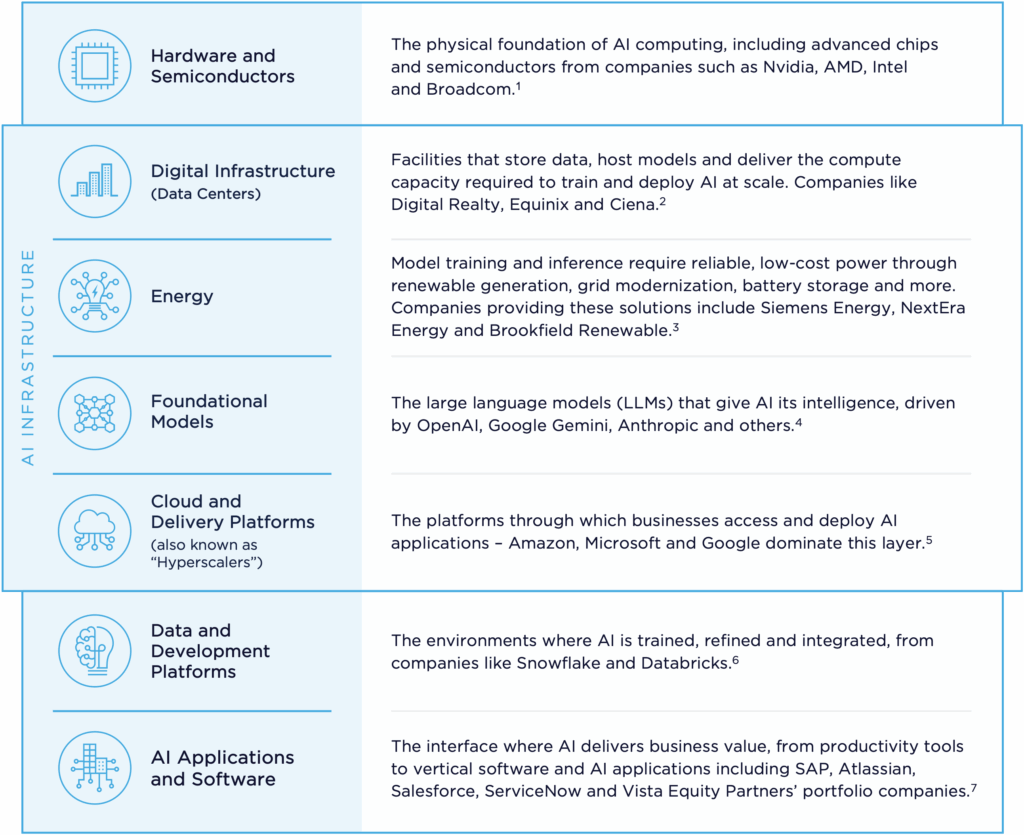
The Intelligent City: A Metaphor for AI
To visualize how these layers interact, imagine AI as a modern city where each element depends on the others to function.
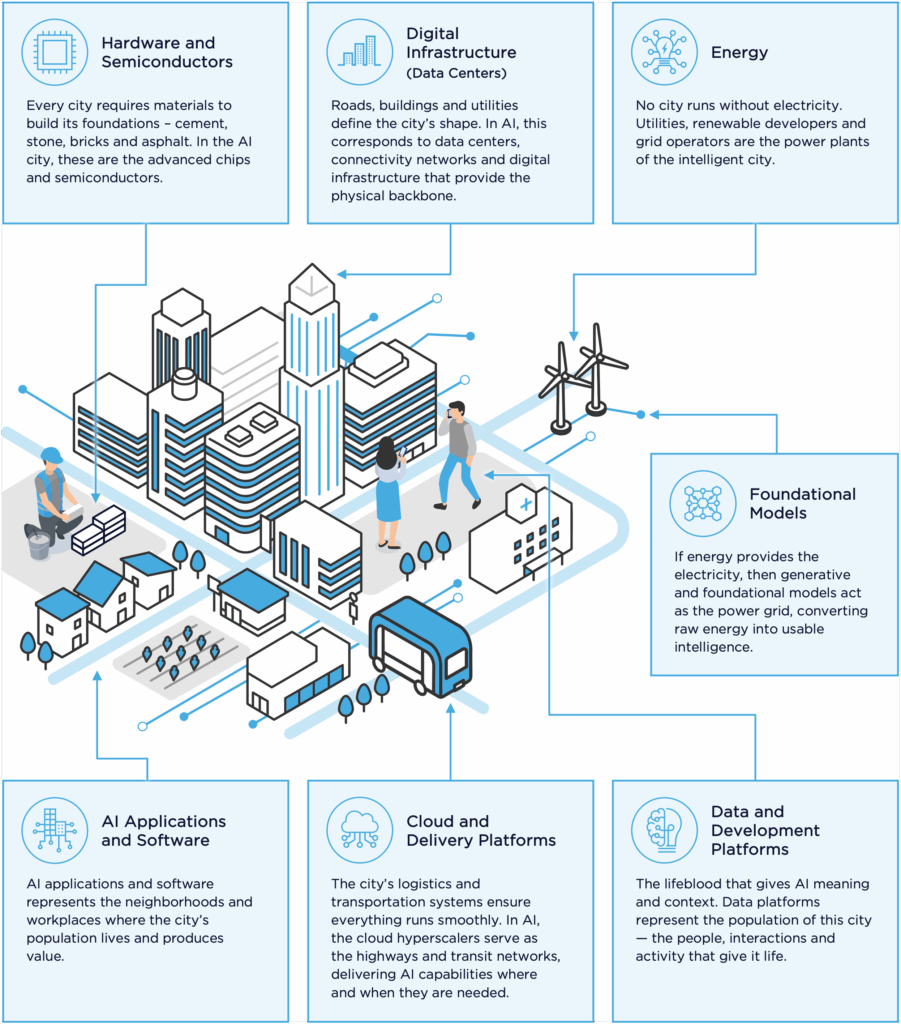
Waves
As with prior major technological shifts, we expect value creation from AI to occur in waves, with various layers described above benefitting at different points throughout the innovation cycle. A historical parallel is the creation of the internet, when value was first concentrated in semiconductors, then moved to infrastructure and devices, and finally to software and services.
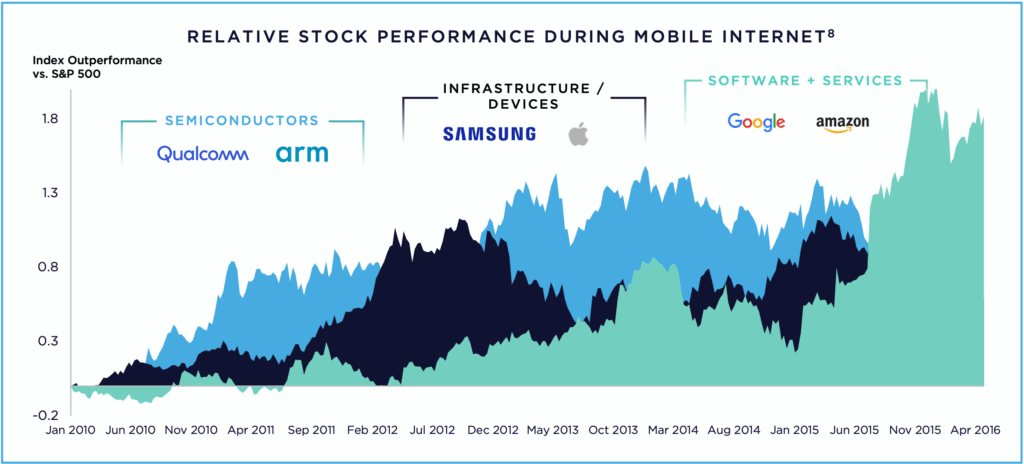
As Mark Twain said, “History doesn’t repeat itself, but it often rhymes.” We hypothesize that a similar pattern could emerge with AI, where value creation will move from hardware to infrastructure to software and AI applications. That said, with the pace of AI evolution it is possible that new layers of value creation may emerge.
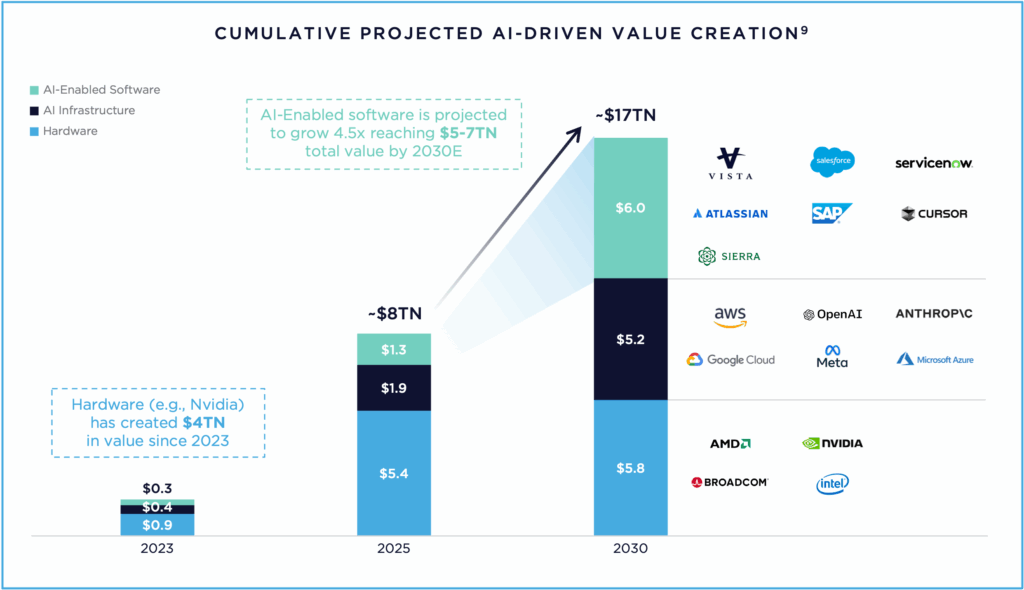
As estimated by Bain, approximately $8.2 trillion in value has already been created, as measured by the market capitalization or private valuations across a basket of companies that lead with an AI-first strategy, develop core AI tools or provide essential AI infrastructure.10
- We are currently experiencing the hardware wave. The AI revolution runs on compute, at exponentially greater processing power. As such, the hardware layer has accrued the most significant share of total value. Nvidia alone represents over half of the value created in 2025. Since January 2023, the company’s market cap has grown from $400 billion to over $5 trillion.11
- The AI infrastructure wave is gaining momentum, driven by the foundational models and hyperscaler platforms which make AI models and capacity widely available to enterprises and consumers. Underlying this wave is massive investments in data centers and related infrastructure to meet expected demand. OpenAI alone has signed more than $1.4 trillion of infrastructure deals in 2025 to build out the data centers it needs to meet demand.12
We believe the AI applications and software wave could be the ultimate destination for value creation, as it is the bridge between the power of AI and its practical adoption in the world and the business environment.
Think Waves To Form Your Investment View
Forming your investment view requires understanding where value has already accrued and where future value will likely accrue across the layers.
- Hardware has been the foundation of AI value creation. Explosive demand for GPUs and advanced semiconductors has driven extraordinary pricing power for leaders like Nvidia and AMD. The bull case rests on continued model complexity and global compute expansion. Yet this wave may be approaching maturity. Market concentration is high and valuations are stretched. Advances in model efficiency may reduce incremental hardware demand, suggesting a shift from exponential to more normalized growth.
- AI infrastructure remains a long-term growth engine. Continued demand for compute, storage and energy supports a strong case for sustained investment. The key risks are commoditization and high capital intensity. Hardware and model evolution could shorten asset life cycles, while future models and applications may require less compute to deliver similar outcomes. Infrastructure offers durable growth potential, but success will depend on disciplined capital deployment and technological adaptability.
- AI applications and software represent AI’s most dynamic frontier. The bull case lies in accelerating enterprise adoption and expanding addressable markets. Incumbent software companies that successfully integrate AI into workflows can unlock measurable ROI and recurring revenues, and that value creation should flow to the providers of the AI solutions. The challenge is that many AI-native start-ups operate at negative gross margins and rely on continual funding, while incumbents must adapt quickly to defend market share from both AI-native start-ups and LLMs themselves. The long-term winners will be those able to build sustainable, scalable economics.
Evaluating Investment Opportunities
Public Markets Concentration: What the MAG Seven Reveal
In public markets, the “Magnificent Seven” — Nvidia, Microsoft, Apple, Alphabet, Amazon, Meta and Tesla — now represent roughly 30 to 32 percent of the S&P 500’s total market capitalization.13 This dominance underscores where investor conviction and liquidity have gathered. Nvidia powers the hardware layer, Microsoft, Amazon and Google anchor cloud infrastructure and applications.

The implication is twofold:
- AI exposure across many of the ecosystem layers is already embedded in major public-market equity benchmarks. Investors holding large equity portfolios are effectively invested in AI through the largest technology giants.
- Market breadth is narrowing. Capital is consolidating around a handful of AI-aligned firms with scale advantages in data, compute and distribution.
For investors and financial advisors, this concentration highlights both opportunity and risk: while mega-cap performance continues to shape overall market returns, diversification beyond these leaders – particularly in private markets and infrastructure vehicles – offers differentiated entry points into the broader AI ecosystem.
Opportunities in the Private Markets
Venture Capital
The global investment surge into artificial intelligence is unprecedented in both speed and scale. For context, venture capital (VC) invested roughly $20 billion (adjusted for inflation) into internet companies in 2000.15 This year, VCs are on course to spend over $200 billion,16 including several landmark transactions in the first half of 2025. For example, OpenAI’s $40 billion commitment from SoftBank among others and xAI’s $10 billion funding round.17
Venture capital remains the domain of big winners. If invested in a VC fund, the payoff potential is outsized – top-quartile funds have historically delivered total value-to-paid-in (TVPI) multiples of 3-4x.18
Private Equity
Private equity (PE) is an effective way to capture the diffusion of AI across the economy, and the value that can be created by the transformation of companies going through the AI revolution. Unlike venture capital, PE investors back established companies with real revenues and large customer bases.
Through PE, investors can access companies access companies that have yet to embed AI into workflows and capture significant value creation. For PE-backed private software and AI applications companies specifically, AI powers rapid development of new products and features (like Agentic AI capabilities unlock new revenue streams and expand margins. This stage of investment offers controlled exposure and operational leverage.
Private Credit
As AI adoption accelerates, private credit has emerged as a meaningful contributor to growth. Many private technology firms require flexible, less-dilutive capital to scale AI capabilities from data infrastructure to funding product expansion. The Cliffwater Direct Lending Index has averaged 9.5% annual returns since 2004, making it a compelling risk-adjusted vehicle for investors seeking income and downside protection.19
Infrastructure
According to McKinsey & Company, global demand for data-center capacity could almost triple by 2030, with about 70% of that demand coming from AI-workloads.20 Investing in the physical infrastructure of the AI ecosystem is an opportunity to capture growth driven by AI’s expansion, while anchored in real assets that generate steady income. The asset class also delivers more stable, contracted cash flows and portfolio diversification benefits.
AI Investment Opportunities Across Asset Classes

Risks, Adoption and Historical Parallels
We believe every technological revolution experiences valuation surge before durable expansion. While adoption is advancing at a historic pace, the trajectory of returns and where lasting value will reside remains uneven.
According to the U.S. Bureau of Labor Statistics’ Real Time Population Survey, AI adoption among consumers reached nearly 40% within two years of commercialization, faster than either the personal computer or the internet achieved comparable penetration.22

Corporate adoption is also advancing. According to a 2025 study from Wharton, 82% of the executives are using AI once a week, with 46% using it daily. In 2023, fewer than 37% said they used it once a week.24 However, while use is soaring, a BCG study shows that only 5% of companies are seeing real returns on AI, with 60% of companies seeing minimal increases in revenue and cost savings.25
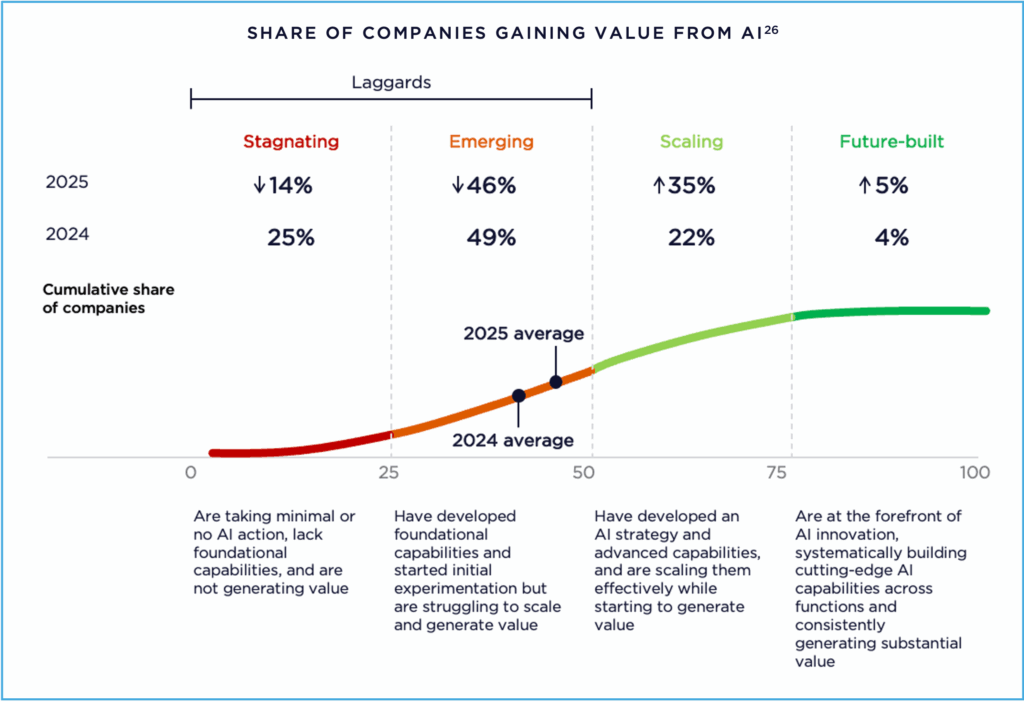
This gap between technological potential and perceived value underscores a familiar pattern in innovation cycles. Some fear today’s AI environment could mirror the dot-com boom of the late 1990s, when many hyped internet businesses, from Pets.com to eToys.com, collapsed under inflated expectations.
Similarly, today’s market includes companies branding themselves as AI-native, positioned as transformative innovators, yet some offer little more than a user interface layered on top of someone else’s foundational model. Many of these companies also lack context and dominion over their data and workflows and often have consumer-like retention rates with most enterprises still in “trial / proof of concept” phase.
That parallel extends to valuations. Periods of rapid technological change can often drive exuberant pricing before fundamentals catch up. This volatility can create both distortion and opportunity.
The companies that ultimately defined the post-dot-com economy were those that paired technological vision with strong balance sheets, real customer demand and scalable business models.
We believe long-term success in AI investing may come from identifying durable enterprises positioned to translate this extraordinary technology into sustained value creation. In this environment, we believe that asset managers and investors with technology domain expertise and experience operating through significant transformations are best equipped to navigate future AI cycles with discipline.
Enterprise Software: The Center of Gravity in the AI Economy
Across every layer of the AI ecosystem one constant remains: the value of technology is only realized when it is put to work. That happens within software, where AI becomes embedded into the daily operating systems of business.
We believe enterprise software represents the most durable conduit for AI-driven value creation. These companies translate the power of AI infrastructure and models into products that enhance productivity, automate workflows and deliver measurable outcomes for end users. As AI adoption matures, we believe the software layer will increasingly serve as the commercial interface between innovation and the economy at large.
Software’s centrality rests on five structural advantages:
- Proprietary Data: Enterprise software platforms sit atop vast stores of operational and customer data, much of it proprietary and non-public. This data becomes a critical input for developing AI models and applications that competitors cannot easily replicate.
- Understanding Business Workflows: Software vendors know where humans are spending time and how business process are architected, which provides a clear ‘jobs-to-be-done’ roadmap for where to deploy AI agents.
- Direct Customer Relationships: Software providers have trusted relationships with end users established over years. This incumbency provides a critical entry point for AI adoption. Additionally, this proximity to customers enables may enable rapid feedback loops for targeted innovation.
- Established Distribution Infrastructure: Many enterprise software firms already have the delivery infrastructure to deploy new AI capabilities at scale, which we believe can accelerate monetization and adoption.
- Quantifiable ROI: AI-powered software can generate tangible financial outcomes: cost savings, revenue uplift, and productivity gains. This measurable return can make it easier for enterprises to justify continued investment and integration.
Final Thoughts
Morgan Stanley estimates that AI adoption in the U.S. could generate nearly $1 trillion in annual economic gains, with roughly half coming from agentic AI, software capable of performing complex tasks with minimal human oversight.27
The competitive differentiator for these companies is likely to increasingly hinge on data sovereignty and model defensibility. Software firms that combine data control with domain expertise and scalable distribution can define the next era of enterprise value creation.
In the same way that the internet redefined the previous decade of innovation, enterprise software is poised to anchor the AI decade ahead. For investors, understanding this layer, where technology becomes productivity and adoption becomes return, may be critical to capturing the potential long-term value of the AI economy.
Download the White Paper
Sources
1 “10 top AI hardware and chip-making companies in 2025,” TechTarget, July 2025.
2 “7 Best Data Center Stocks, ETFs and REITs to Buy Now,” U.S. News. October 2025.
3 “Top 20 AI Energy Companies Transforming the Industry,” AutoGPT, October 2025.
4 “AI50 List” Forbes, April 2025.
5 “The rise of hyperscalers: Reshaping cloud computing and business,” Britannica Money, October 2025.
6 “Snowflake and Databricks vie for the heart of enterprise AI,” CIO, August 2025.
7 Vista analysis as of November 2025.
8 Source: FactSet, Morgan Stanley Research as of 05/2023. Index constituents indicated by logos. Selection of benchmarks or indices is inherently subjective, and others might select other benchmarks or indices based on their assessment of the market. Actual results may differ materially from projections and there can be no assurance that any historical trends will continue. Company logos do not represent Vista or Vista fund investments and do not signify affiliation or endorsement. Certain information herein was prepared by a third party but selected by Vista and although Vista believes that the determinations related to the market backdrop described herein are reasonable, they are inherently subjective in nature. Other market participants may make different determinations relating to the market based on the same underlying data.
9 Source: Bain & Company – GenAI value creation forecast (Q4 2025) Methodology: 2022-2025 actual value creation above S&P, 2026 onward based on estimated revenue growth in category and assumed multiple on this growth.
10 Source: Bain & Company – GenAI value creation forecast (Q4 2025) Methodology: 2022-2025 actual value creation above S&P, 2026 onward based on estimated revenue growth in category and assumed multiple on this growth.
11 “NVIDIA Corporation (NVDA)” Stock Analysis, as of November 13, 2025.
12 “OpenAI CFO Sarah Friar says company isn’t seeking government backstop, clarifying prior comment,” CNBC, November 2025.
13 “‘Magnificent Seven’ earnings expected to beat rest of S&P 500 – but that might not calm high-valuation fears,” Morning Star, October 2025.
14 “The Magnificent Seven’s Market Cap Vs. the S&P 500,” Motley Fool, as of November 18, 2025.
15 “Of course it’s a bubble’: AI start-up valuations soar in investor frenzy,” Financial Times, October 2025.
16 “Of course it’s a bubble’: AI start-up valuations soar in investor frenzy,” Financial Times, October 2025.
17 AI startups raised $104 billion in first half of year, but exits tell a different story,” CNBC, July 2025.
18 “The Complete Guide to Venture Capital Fund Metrics” Going VC, July 2025.
19 Cliffwater Direct Lending Index” as of October 2025.
20 “The cost of compute: A $7 trillion race to scale data centers,” McKinsey, April 2025.
21 Vista analysis. Classification is inherently subjective and may be different from other’s assessment of the market.
22 “The Rapid Adoption of Generative AI,” Federal Reserve Bank of St. Louis, 2024.
23 Federal Reserve Bank of St. Louis, 2024.
24 “Accountable Acceleration: Gen AI Fast-Tracks Into the Enterprise,” Knowledge at Wharton, October 2025.
25 “The Widening AI Value Gap” BCG, October 2025.
26 The Widening AI Value Gap” BCG, October 2025.
27 AI Could Affect 90% of Occupations,” Morgan Stanley, September 2025.
Disclosures
This document does not constitute an offer to sell any securities or the solicitation of an offer to purchase any securities. This document discusses broad market, industry or sector trends, or other general economic, market or political conditions and should not be construed as research, investment advice, or any investment recommendation.
Statements contained in this document (including those relating to current and future market conditions and trends in respect thereof) that are not historical facts are based on current expectations, estimates, projections, targets, opinions, beliefs, and/or assumptions Vista considers reasonable. Such statements involve known and unknown risks, uncertainties and other factors, and undue reliance should not be placed thereon. In addition, no representation or warranty is made with respect to the reasonableness of any estimates, forecasts, illustrations, prospects or returns, which should be regarded as illustrative only, or that any profits will be realized. Certain information contained herein constitutes “forward-looking statements,” which can be identified by the use of terms such as “may”, “will”, “should”, “expect”, “project”, “estimate”, “intend”, “continue”, “target” or “believe” (or the negatives thereof) or other variations thereon or comparable terminology. Due to various risks and uncertainties actual events or results may differ materially from those reflected or contemplated in such forward-looking statements. No representation or warranty is made as to future performance or such forward-looking statements.
Certain information contained in this document has been obtained from published and non-published sources prepared by other parties, which in certain cases have not been updated through the date hereof. While such information is believed to be reliable, Vista does not assume any responsibility for the accuracy or completeness of such information and such information has not been independently verified by it. Except where otherwise indicated herein, the information provided in this document is based on matters as they exist as of the date of preparation of this document and not as of any future date and will not be updated or otherwise revised to reflect information that subsequently becomes available, or circumstances existing or changes occurring after the date hereof, or for any other reason.
No representation or warranty, either express or implied, is provided in relation to the accuracy or completeness of the information contained herein.
The use of artificial intelligence (“AI”) is increasing rapidly, which presents both significant opportunities for growth and competitive advantage, but also introduces substantial risks to Vista and its investments. The field of AI is characterized by rapid and ongoing technological innovation. While this presents significant opportunities for growth and competitive advantage, it also introduces a substantial risk of technological obsolescence. Even if the AI-related initiative described herein is successfully implemented, Vista could be outpaced by competitors who develop more advanced, efficient, or cost-effective technologies. Additionally, breakthroughs in areas such as quantum computing, machine learning algorithms, or data analytics could rapidly render existing technologies and business models obsolete. Accordingly, any direct or indirect investment in Artificial Intelligence carries a significant risk of depreciation due to technological obsolescence and the value of such investment could decline if the investment failed to stay at the forefront of technological advancements.
